Commercial Salmon Fisheries
Southeast Alaska & Yakutat Research: Pink Salmon
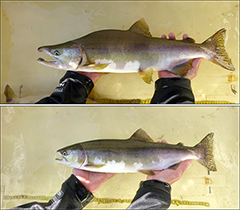
Figure 1. — Click for more Info
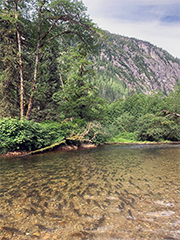
Figure 2. — Click for more Info
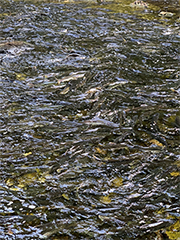
Figure 3. — Click for more Info
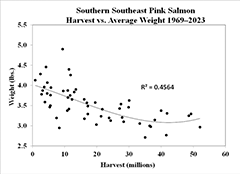
Figure 4. — Click for more Info
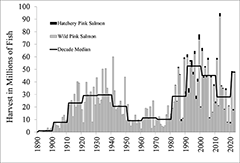
Figure 5. — Click for more Info
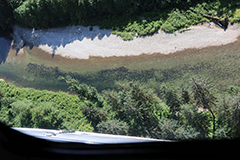
Figure 6. — Click for more Info
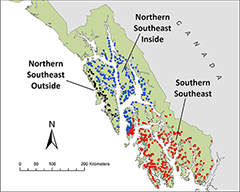
Figure 7. — Click for more Info
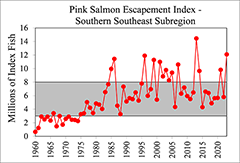
Figure 8a. — Click for more Info
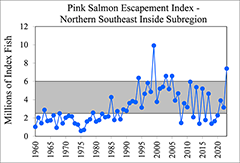
Figure 8b. — Click for more Info
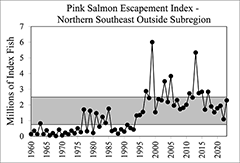
Figure 8c. — Click for more Info
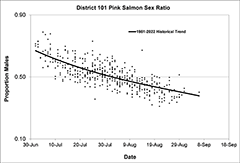
Figure 9. — Click for more Info
Introduction
Pink salmon (Oncorhynchus gorbuscha) are the smallest and most numerous of the Pacific salmon in Alaska (Figures 1–3). Pink salmon are known to spawn in over 2,500 streams in Southeast Alaska and can be found in nearly any stream large enough to accommodate them, particularly in years of high abundance. Pink salmon in Southeast Alaska are approximately 3.5 pounds on average (1969–2023), but average weights are variable and tend to be lower in years of high abundance (Figure 4). Due to their 2-year life cycle, odd and even year pink salmon runs are segregated from each other, which can lead to either odd or even year runs becoming dominate for periods of time. Since 1960, both odd and even year runs have generally followed similar trends.
Pink Salmon in Southeast Alaska Fisheries
Since 1960, an average of 30 million pink salmon per year were harvested in the commercial fishery in Southeast Alaska with a range of 3 million (1960 and 1967) to 95 million (2013) fish (Figure 5). Pink salmon harvests were very low from the 1950s through 1970s (average harvest = 11 million) before climbing dramatically as run sizes increased during the 1980s. High pink salmon run sizes and harvest levels were maintained from the mid-1980s through mid-2000s (average harvest = 46 million). Since 2005, pink salmon harvests have been more variable primarily due to weaker even-year runs, but have averaged 33 million since that time.
Pink salmon accounted for an average 64% of all the salmon harvested in Southeast Alaska over the past decade. The exvessel value of the commercial pink salmon harvest averaged approximately $27 million a year, and ranged between $6 and $124 million, making pink salmon the most valuable species after chum salmon (O. keta) in Southeast Alaska fisheries. The majority of pink salmon harvested in Southeast Alaska commercial fisheries have been taken by purse seine gear (94%), with smaller portions harvested in drift gillnet (5%), troll, and set gillnet fisheries (10-year average). Small numbers of pink salmon have been harvested in subsistence, personal use, and sport fisheries. Nearly all of the pink salmon harvested in Southeast Alaska are of wild origin; hatchery-produced pink salmon have contributed an average of only 5% of the total annual harvest and 2% of the common property harvest since the mid-1990s (Figure 5).
Escapement Monitoring
Pink salmon stocks in Southeast Alaska are managed through extensive inseason monitoring of harvests, fishing effort, and developing escapements. Because pink salmon production is broadly dispersed across Southeast Alaska, inseason assessment of escapements has been based on aerial observation. Although fishery managers fly these surveys to assess inseason abundance and make management decisions (Figure 6), a numerical summary of their visual impressions about salmon abundance is retained as one of the most important indicators of salmon abundance and management success. The peak annual aerial survey counts of over 700 streams in the region are used to generate an annual escapement measure, or "index" of abundance, on which pink salmon escapement goals are based. Escapement goals have been established for aggregates of pink salmon runs in three broad subregions in Southeast Alaska: Southern Southeast Subregion, Northern Southeast Inside Subregion, and Northern Southeast Outside Subregion (Figure 7).
Marine tagging studies have repeatedly demonstrated that Southeast Alaska pink salmon stocks are strongly segregated into southern and northern areas or subregions, and the commercial fisheries in each subregion generally target pink salmon stocks that ultimately spawn in that subregion. The Southern Southeast Subregion comprises pink salmon stocks from Sumner Strait and south (districts 1–8), while the Northern Southeast Subregion comprises pink salmon stocks north of Sumner Strait (districts 9–15). The northern area was further divided into Northern Southeast Inside and Northern Southeast Outside subregions, as marine tagging studies also showed that pink salmon spawning on the outer coast of Chichagof and Baranof Islands generally do not enter inside waters. The Northern Southeast Outside Subregion includes all waters of District 13 (excluding Peril Strait and Hoonah Sound, which are part of the Northern Southeast Inside Subregion). There are 366 index streams in the Southern Southeast Subregion, 295 index streams in the Northern Southeast Inside Subregion, and 41 index streams in the Northern Southeast Outside Subregion (Figure 7).
Similar to harvest trends, escapements of pink salmon were very low in the 1960s and 1970s but began steadily increasing in the late 1970s (Figure 8). Escapements of pink salmon in Southeast Alaska continued to rise into the 1990s and have generally remained well above escapement levels of the 1960s and 1970s due to larger average run sizes and management efforts to ensure escapement goals are met throughout the region. The current biological escapement goals for pink salmon in Southeast Alaska are 3.0 to 8.0 million index spawners in the Southern Southeast Subregion, 2.5 to 6.0 million index spawners in the Northern Southeast Inside Subregion, and 0.75 to 2.5 million index spawners in the Northern Southeast Outside Subregion. The Southern Southeast Subregion escapement goal has been met annually since 1974 and the Northern Outside Subregion escapement goal has been annually since 1994 (Figure 8). The escapement goal for the Northern Southeast Inside Subregion has been met in most years since the late 1980s, with the exception of even years between 2008 and 2020.
Pink Salmon Forecasting
Pink salmon stocks in Southeast Alaska are managed through extensive inseason monitoring of harvests, fishing effort, and developing escapements. Prior to making decisions about commercial fishery openings, experienced fishery managers fly over many miles of pink salmon spawning habitat, adjacent estuaries, and nearby marine waters to assess whether adequate numbers of salmon are present, and whether the timing of the escapement is consistent with previous patterns. In addition, harvest and effort in prior openings can be compared to previous years to assess run strength and forecast how the run is likely to proceed. The portion of male to female pink salmon (data collected by port sampling staff) can be used as an indication of run timing, which helps assess the strength of a run. Early in the run, pink salmon harvests in marine waters tend to be composed of a high proportion of male pink salmon (65% or higher) but the proportions of males and females approach 50% at the peak of the run and shift towards more females in the late stages of the run (Figure 9).
Preseason Harvest Forecast
Although the inseason management of pink salmon stocks is focused on monitoring daily harvest and fishing effort, and using aerial survey counts to assess whether adequate numbers of pink salmon are present to meet escapement goals, the fishing industry benefits from preseason forecasts to plan appropriately for the harvest, processing, transportation, and marketing of these fish. Pink salmon runs are notoriously difficult to forecast due to the species’ propensity to respond dramatically to changes in the marine environment, the odd- and even-year cycles of abundance, and the fact that there is only one age class in the fishery each year. With only a 2-year life cycle, information about cohort strength is not available from jacks or siblings as with other species of salmon and sibling recruit modeling is not possible with pink salmon.
NOAA Alaska Fisheries Science Center, Auke Bay Laboratories initiated the Southeast Alaska Coastal Monitoring (SECM) project (Southeast Alaska Coastal Monitoring | NOAA Fisheries) in 1997 to identify relationships between the year-class strength of juvenile salmon and the biophysical parameters influencing their growth and survival, their prey and predator interactions, their habitat utilization, and their stock interactions in marine waters. A major finding of the SECM survey is that relative abundance of juvenile pink salmon in June and July was highly correlated to harvest of adults in the subsequent year. As a result, NOAA used peak juvenile pink salmon catch per unit effort (CPUE) and environmental information collected during SECM surveys to forecast the Southeast Alaska pink salmon harvest starting in 2004. In the past, ADF&G and NOAA produced separate Southeast Alaska preseason pink salmon forecasts and in 2007, ADF&G began adjusting their simple trend forecasts with juvenile pink salmon abundance data from the SECM survey. Since 2018, ADF&G and NOAA scientists collaborate each year to create a joint preseason forecast and the SECM project is now conducted cooperatively by NOAA and ADF&G using the ADF&G research vessel Medeia. The current approach to forecast the adult pink salmon harvest is to use a multiple regression model with juvenile pink salmon CPUE (a proxy for abundance), along with environmental variables including temperature data from the SECM survey or from satellite sea surface temperature data, and other potential environmental variables. Together, both agencies continue to examine alternative variables and statistical methods to improve annual forecasts of pink salmon.
Southeast Alaska Salmon, Alaska Department of Fish and Game
Selected Publications
- Pink salmon stock status and escapement goals in Southeast Alaska through 2019. (PDF)
- Pink salmon stock status and escapement goals in Southeast Alaska through 2016 (PDF)
- Pink salmon stock status and escapement goals in Southeast Alaska through 2013 (PDF)
- Pink salmon stock status and escapement goals in Southeast Alaska through 2010 (PDF)
- Pink salmon stock status and escapement goals in Southeast Alaska and Yakutat through 2008 (PDF)
- Pink salmon stock status and escapement goals in Southeast Alaska and Yakutat through 2002 (PDF)
- Standardizing and Automating the Southeast Alaska Pink Salmon Escapement Index (PDF)
- Southeast Alaska pink salmon forecasting models. (PDF)
- Operational Plan: Southeast Alaska pink salmon escapement index surveys, 2021 (PDF)
- Southern southeast Alaska pink salmon tagging investigations, 1981. Southeast Alaska stock separation research project, annual report - 1982 (PDF)
